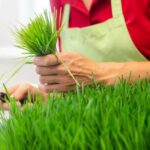Looking for landscaping ideas along fence to enhance the overall look of your property? Landscaping along a fence can provide a beautiful backdrop for your outdoor space, adding color, texture, and visual interest. Whether you want to create privacy, attract wildlife, or simply enhance the aesthetic appeal of your yard, there are plenty of creative ways to use plants and decorative elements to elevate your fence line.
When it comes to landscaping along a fence, choosing the right plants is crucial. Factors such as sunlight, soil type, and maintenance requirements should all be taken into consideration when selecting the best plants for your specific needs. Additionally, incorporating vertical gardening with hanging planters and trellises can maximize your space and add an extra dimension to your fence line.
In this article, we will explore various landscaping ideas for fences that go beyond just planting flower beds. From enhancing privacy with strategic plant placement to incorporating low-maintenance options for busy homeowners, there are endless possibilities to transform your outdoor space with the right landscaping along a fence. Get ready to discover how you can create a vibrant and inviting atmosphere that complements the overall look of your property.
Choosing the Right Plants
Landscaping along a fence can significantly enhance the overall look of a property, adding visual interest and creating a cohesive, polished appearance. When it comes to choosing the right plants for landscaping along a fence, there are several important factors to consider. From sunlight and soil type to maintenance requirements, selecting the best plants will ensure a successful and thriving landscape.
Here are some tips for selecting the best plants for landscaping along a fence:
- Consider the amount of sunlight: Before choosing plants, take note of the amount of sunlight that reaches the area along your fence. Some plants thrive in full sun, while others prefer shade. Take this into account when selecting your plant species.
- Evaluate soil type: Different plants have different soil preferences, so it’s important to assess the soil type in your desired planting area. Whether you have sandy, loamy, or clay soil, there are suitable plant options for each type.
- Maintenance requirements: Be realistic about the amount of time you can dedicate to maintaining your landscaping. Some plants require more regular care than others, so choose species that align with your maintenance capabilities.
By carefully considering these factors, you can select plants that will thrive in their specific location along the fence line and contribute to a beautiful and harmonious outdoor space.
When choosing plants for landscaping along a fence, it’s important to create an appealing and balanced design while also taking maintenance needs into consideration. Whether you prefer low-maintenance options or more intricate landscaping plans, finding the right balance is key to achieving an aesthetically pleasing result.
Vertical Gardening
Hanging Planters
One creative way to incorporate vertical gardening along a fence is by using hanging planters. These can be hung directly on the fence itself or from a system of hooks or wires installed along the top of the fence.
Choose cascading plants such as petunias, ivy, or trailing succulents to create a beautiful green wall effect. Hanging planters come in a variety of materials including metal, wicker, and ceramic, allowing you to customize the look to complement your overall landscaping design.
Trellises
Another popular option for vertical gardening along a fence is to install trellises. These can provide support for climbing plants such as clematis, jasmine, or climbing roses. Trellises come in various styles and sizes, from simple wooden lattice panels to intricate wrought iron designs. By incorporating trellises into your landscaping along the fence line, you can add height and texture to your outdoor space while also creating a sense of privacy.
Maintenance Tips
When using hanging planters and trellises for vertical gardening along a fence, it’s important to consider maintenance requirements. Ensure that hanging planters have proper drainage and are securely attached to the fence to prevent damage or accidents.
Additionally, regularly check that trellises are stable and in good condition to support the weight of climbing plants as they grow. With proper care and maintenance, vertical gardening along a fence can provide an eye-catching and practical addition to your landscaping design.
Privacy Screening
Creating privacy along a fence line can be achieved through strategic landscaping choices. One effective way to create privacy is by incorporating tall plants such as ornamental grasses, bamboo, or evergreen shrubs. These plants not only add greenery and beauty but also serve as a natural barrier between your outdoor space and the surrounding area.
Another option for creating privacy is by using climbing plants on trellises or lattice panels attached to the fence. This not only adds an aesthetic element but also provides an effective screen from neighboring properties.
In addition to using plants, natural elements such as wooden or bamboo screens can be used to enhance privacy along a fence line. These screens can be placed strategically to block direct lines of sight into your outdoor living spaces. Incorporating these elements not only provides seclusion but also adds visual interest and texture to the overall landscaping along the fence.
For those wanting a more eco-friendly approach, hedges made up of dense shrubs or trees can be planted strategically along the fence line to provide privacy. Not only do they offer a barrier from neighboring properties, but they also attract wildlife and contribute positively to the local ecosystem. By carefully selecting and positioning these natural elements, it is possible to create a private sanctuary within your outdoor space while enhancing the overall look of your property.
| Landscaping Element | Benefits |
|---|---|
| Tall plants (ornamental grasses, bamboo, evergreen shrubs) | Natural barrier, aesthetic appeal |
| Climbing plants on trellises or lattice panels | Effective screen, visual appeal |
| Natural screens (wooden or bamboo) | Privacy, visual interest |
Adding Decorative Elements
When it comes to landscaping along a fence, adding decorative elements can take your outdoor space to the next level. Incorporating outdoor art, garden statues, and lighting can enhance the overall look of your fence line and create a more visually appealing and inviting environment. There are various creative ways to incorporate these decorative elements, making them an essential aspect of your landscaping design.
Outdoor Art
One way to enhance the landscaping along a fence is by incorporating outdoor art. This can include sculptures, mosaics, or even painted murals on the fence itself. Outdoor art can add a unique touch to the space and serve as a focal point for the landscaping. When choosing outdoor art pieces, consider the overall aesthetic of your outdoor space and select pieces that complement the style of your landscaping.
Garden Statues
Another way to enhance the visual appeal of your fence line is by adding garden statues. These can range from classical sculptures to whimsical figurines, depending on your personal style and preferences. Garden statues can add personality and charm to the landscape while creating points of interest throughout the area.
Lighting
Incorporating lighting along a fence not only adds an element of safety and security but also enhances the ambiance of the outdoor space. You can use string lights, lanterns, or spotlights to illuminate specific areas along the fence line and highlight key features in your landscaping design. Additionally, lighting can extend the usability of your outdoor space into evening hours, allowing you to enjoy your beautifully landscaped area at any time of day.
By incorporating these decorative elements into your landscaping along a fence, you can create a visually stunning outdoor space that reflects your personal style and enhances the overall look of your property while attracting attention from passersby with captivating visual appeal.
Low-Maintenance Options
When it comes to landscaping along a fence, low-maintenance options can be a great choice for busy homeowners. These landscaping ideas can help create a beautiful and functional outdoor space without requiring a lot of time and effort to maintain. Here are some low-maintenance landscaping ideas that are perfect for busy homeowners:
- Native Plants: Choose native plants that are well-suited to your climate and soil type. Native plants are naturally adapted to the local environment, so they require less water, fertilizer, and maintenance compared to non-native species.
- Mulch: Use mulch to help retain moisture in the soil, suppress weed growth, and improve the overall appearance of the landscaping. Organic mulches like wood chips or shredded bark can also break down over time, adding nutrients to the soil.
- Drought-Tolerant Plants: Consider incorporating drought-tolerant plants into your landscaping design. These plants have evolved to survive with minimal water, making them an excellent choice for low-maintenance landscapes.
In addition to these specific ideas, there are other strategies that can help reduce maintenance requirements in your fence-line landscaping:
- Automatic Irrigation Systems: Install an automatic irrigation system to ensure that your plants receive consistent watering without the need for manual intervention.
- Perennial Plants: Select perennial plants that come back year after year without needing to be replanted. This can save you time and effort in maintaining your garden bed.
- Hardscaping Elements: Incorporate hardscaping elements such as rocks, gravel pathways, or decorative stones to minimize the amount of greenery that needs regular attention.
By incorporating these low-maintenance landscaping ideas along their fence line, busy homeowners can enjoy a beautiful outdoor space without feeling overwhelmed by maintenance tasks. With careful planning and plant selection, it’s possible to create a visually appealing and sustainable landscape that enhances the overall look of the property while minimizing the time and effort required for upkeep.
Creating a Wildlife-Friendly Habitat
When considering landscaping ideas along a fence, it’s important not only to enhance the aesthetic appeal of your property but also to create a welcoming environment for wildlife. One way to achieve this is by incorporating native plants that attract birds, butterflies, and other wildlife to the fence line. Native plants are well-adapted to the local climate and soil conditions, making them an ideal choice for creating a sustainable and wildlife-friendly habitat.
One popular native plant option for attracting wildlife is the purple coneflower (Echinacea purpurea), which attracts birds and butterflies with its nectar-rich blooms. Additionally, plants such as milkweed (Asclepias) are essential for supporting monarch butterflies during their migration. By carefully selecting native plants that provide food and shelter for local wildlife, you can create a thriving ecosystem right along your fence line.
Incorporating a variety of native plants with different blooming periods ensures that there is always a food source available for wildlife throughout the year. In addition to providing food sources, consider adding features such as birdbaths or butterfly feeders to further attract and support local wildlife in your landscaped area along the fence.
| Native Plant | Wildlife Attracted |
|---|---|
| Purple Coneflower (Echinacea purpurea) | Birds, Butterflies |
| Milkweed (Asclepias) | Monarch Butterflies |
Maintenance and Care
In conclusion, landscaping along a fence can greatly enhance the overall look and feel of a property. By carefully selecting the right plants, incorporating vertical gardening techniques, creating privacy screening, adding decorative elements, and considering low-maintenance options, homeowners can personalize their outdoor space to reflect their style and needs. Additionally, creating a wildlife-friendly habitat along the fence line can bring natural beauty and diversity to the landscape.
Choosing the right plants for landscaping along a fence is crucial in ensuring the success of the design. Considering factors such as sunlight, soil type, and maintenance requirements will help homeowners select plants that will thrive in their specific environment. Vertical gardening is another creative option for adding visual interest to a fence line. Utilizing hanging planters and trellises can maximize space and create a lush green backdrop.
To keep landscaping along a fence looking its best all year round, proper maintenance and care are essential. Regular watering, fertilizing, pruning, and weeding will help to preserve the health and beauty of the plants. By following these tips and taking advantage of various landscaping ideas along a fence, homeowners can transform their outdoor space into a personalized oasis that enhances both the beauty and functionality of their property.
Frequently Asked Questions
How Do You Landscape Next to a Fence?
When landscaping next to a fence, it’s important to consider the space available and the amount of sunlight the area receives. You can plant smaller shrubs or flowers for a softer look, or opt for taller plants for added privacy. Adding mulch or decorative stones around the base of the fence can help create a clean and polished appearance.
What Is the Best Bush to Plant Along a Fence?
The best bush to plant along a fence depends on your specific needs and preferences. For privacy and security, consider planting dense evergreen bushes like boxwood or holly. If you’re looking for something more decorative, flowering bushes such as hydrangeas or roses can add color and beauty to your fence line.
How Can I Make My Fence Look Better?
To make your fence look better, you can start by giving it a fresh coat of paint or stain if it’s made of wood. Adding decorative elements like hanging baskets, trellises with climbing vines, or outdoor art can also enhance its appearance.
Regular maintenance such as cleaning, trimming overgrown vegetation, and repairing any damage will keep your fence looking its best.

Welcome to my gardening blog! I am passionate about plants and enjoy sharing my knowledge and experiences with others. In this blog, I will write about everything related to gardening, from tips on how to get started to updates on my own garden projects.





